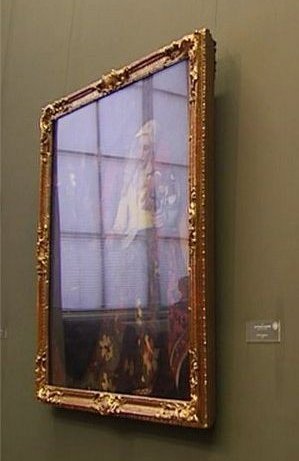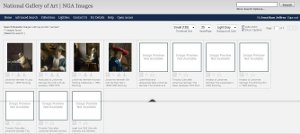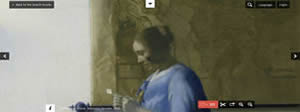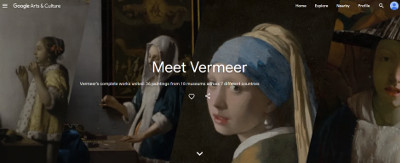Digital images of artworks, which have all but replaced traditional color slides, are essential for scholarly study and teaching, but they are likewise economically valuable. Many museums offer only thumbnail images, watermark their images, prohibit downloading, or simply keep their collections offline. A few pioneering institutions have adopted an open access policy offering free of charge and free of copyright high-quality digital images of their works of art.
In one format or another, high-resolution digital images of 29 paintings by Vermeer are currently accessible to the WWW navigator, free of charge. Some of these can be downloaded onto the user's hard disk. The remaining can only be viewed online via one of the various viewing interfaces which allows zooming and panning. The zoom interfaces have the drawback that only limited areas of the picture's total surface can be viewed at any given moment at maximum resolution.
Advantages and disadvantages in viewing today's high-resolution images of artworks

Johannes Vermeer
c. 1665–1667
Oil on panel, 23.2 x 18.1 cm.
National Gallery of Art, Washington, D.C.
There is much to be said for today's state-of-the-art digital images of artworks. The level of detail and the accuracy of color of the best digital images are such that they offer various advantages to viewing real works in museums, especially during temporary exhibitions when the viewing conditions of the artworks can be seriously compromised by broader exhibition interests.
Crowds, glare, dim light and the impossibility of examining paintings at close range (to say nothing the inaccessibility of the important art collections to a great part of the world's population) are all factors that seriously inhibit the study and appreciation of many works of art. For example, to expect Vermeer's Guitar Player to reveal its nuanced beauty in the faint light of the barely illuminated Kenwood House where the picture is permanently housed is to ask too much of any painting, whatever its artistic merit.
However, viewing digital images of artworks present important lacunae with respects to the original artworks they represent. Digital images are formed by side-by-side pixels which emit different frequencies of light. Paintings are instead, three-dimensional physical objects made of successive layers of variegated substances that combine in unique and unusual manners. Obviously, even in the best of cases, a painting's dimensions and texture, both absolutely crucial components of any serious viewing experience, are lost in even the most sophisticated digital image.

However, notwithstanding the continual debate as to the advantages and disadvantages of digital images of artworks, digital images should not be considered adversaries to original artworks, but close allies when used properly. Good digital images of artworks can pique the neophyte's curiously, confirm and renew the museum goer's on-the-spot impressions. They may also greatly facilitate scholarly research by allowing extended viewing and the possibility of comparing multiple works of art at an extremely low cost.
In any case, although there remain various technical limits concerning resolution and viewing of high-resolution digital images, we have reached to the point where any significant increase in magnification of small, "cabinet" pictures like those of Vermeer is likely to be of use only for conservators.
Art institutions and the standardization of digital images
The methodology for art reproduction in color requires a detailed process to capture artworks faithfully. Essential to this is color management, utilizing standardized color spaces to ensure consistency across devices. Proper daylight-balanced lighting is crucial, while high-resolution cameras or scanners, depending on the artwork's size and nature, capture the piece. Regular device and monitor calibration ensures color fidelity. Specialized software processes the images, correcting any distortions or color imbalances. The chosen reproduction material, such as paper or canvas, also impacts color, necessitating careful selection. A proof is typically produced for final checks, and the reproduction process is documented for future reference or replication.
Art institutions are increasingly digitizing their collections for preservation and improved accessibility. A primary concern in this effort is digital image standardization, ensuring artworks are consistently represented, facilitating comparison and broader access. This standardization assists in preservation and simplifies sharing among institutions. Key technical aspects include resolution, color accuracy, file formats, and detailed metadata. Given potential copyright concerns, especially for contemporary art, protective measures like watermarking might be included. Organizations like the International Imaging Interoperability Framework (IIIF) provide guidelines to maintain the quality and consistency of digital artworks, ensuring adaptability to evolving technology.
However, until recent years, most museum websites featured digital images of their artworks which, regarding color and resolution, were little more than rough approximations.
Many museums appear not even to be aware of the basic issues of digital accuracy. Adjustments in color and contrast are not infrequently made by the photographer who tweaks the image in Photoshop sitting in front of the picture until he arrives at what, in his judgment, is an acceptable result. This practice, known as "visual editing," is widespread. In fact, in a case study of four institutions, two paintings were imaged and processed through each museum's normal digital workflow and due to the many dissimilarities among the digital camera systems and workflows, there was a significant range in the quality of the digital masters.
A survey of American art institutions (2005) revealed that while 94% were found to be increasing the use of digital photography, most of the tasks are performed manually. Only 20% reported any form of automated processing. Visual editing was used by 79%. Local changes with masks and filling in missing parts were made by 48% while 58% used sharpening. Respondents showed they were still lacking knowledge about the new systems and about critical aspects such as color.
The concept of an international color standard, which ensures accuracy independently from personal judgment, has slowly begun to make breach the museum community. Progress has been relatively slow due to technical obstacles and the costs of rapidly evolving digital photography systems. In the case of large institutions which house a sizable part of the world's masterworks familiar to the greater public, the difficulties are compounded by the logistical hurdles of photographing and archiving thousands of images.
Digital images and museums with Vermeer paintings
The National Gallery

During the mid-1990s, in collaboration with other museums, universities and commercial enterprises, the National Gallery of London participated in a EC-supported MARC PROJECT (Methodology for Art Reproduction in Colour). The project developed a new, large-format digital camera capable of making images up to 20,000 x 20,000 pixels. Prototype MARC cameras were installed in the National Gallery and the Alte Pinakothek in Munich. After five years of development, the initial tungsten halogen photographic lamps used to illuminate the artworks were replaced by new, brighter HMI lights. HMI light emits light that approximates the optimal light temperature of c. 6500 K, recommended by the Commission Internationale de l'Eclairage.
To speed up image acquisition and bear heavy, continuous work, it was decided to employ the MARC II camera, already in use at the Library of Congress in Washington. The National Gallery developed its own user interface to control the camera's settings and the storage of images. Aside from the staff needed for the acquisition and storage of the digital images, a special laboratory was built on the lower floors of the gallery and the members of Art Handling Staff were increased to manage the continual transportation to and from the laboratory. Museum policy requires that paintings that are photographed must be returned to the gallery before the end of the day. The gallery's workflow now processes from 6 to 7 paintings a day, far more than the hundred or so per year when the project was initiated. By using the Gretag Macbeth 24-patch color rendition chart, inconsistencies in lighting can be corrected for each painting ensuring that the quality of the last image captured is as high as the first.
Monitor Calibration
Calibrating your monitor ensures accurate color and contrast display. Start by setting up a consistent environment away from direct sunlight. Reset your monitor to factory settings and adjust brightness and contrast. For precise calibration, use a hardware colorimeter like the Datacolor SpyderX or X-Rite i1Display Pro. This device, combined with its software, measures and adjusts your monitor's colors. If you don't have a colorimeter, Windows and macOS offer built-in calibration tools. After calibration, review images to validate accuracy. Regularly recalibrate every 1-2 months or more frequently for high-demand tasks. Proper calibration enhances color representation on your monitor.
In order to ensure that the colors of your computer screen match those of the high-standard digital image, regular monitor calibration is recommended.
For Mac OSX operating system use Display Calibrator Assistant. http://www.macworld.com/article/1151706/calibrateyourmonitor.html
For PC with Microsoft Windows use Adobe Gamma that comes as part of the Photoshop package.
http://www.ehow.com/how_2111986_use-adobe-gamma.html
Pixie (Nattyware) is a utility made especially for webmasters and designers which returns the hex, RGB, HTML, CMYK and HSV values of a given color on the computer screen indicated by the position of the cursor.
Today, each image from the files of the National Gallery Company Online Picture Library is consistent with any other, meaning that informed comparisons about color, tone and brightness can be made, ensuring as well, consistent production to print.
Many of these images are available on the National Gallery website. Moreover, the gallery's interactive, full-screen zoom feature counts as one of the most practical on the web. The resolution of these images is, however, scaled down from their original dimensions.
The only shortcoming of the National Gallery image policy is that their digital images cannot be downloaded onto the navigator's hard disk and utilized offline. However, there exist various "artisanal" techniques to acquire the full images for personal use, provided one is endowed with patience and is discreetly skilled in handling digital image manipulation programs like Photoshop or Gimp.
Both Vermeers owned by the gallery (and Kenwood House The Guitar Player) are available in high-resolution.
On the occasion of the Vermeer and Music: The Art of Love and Leisure exhibition, the gallery has provided new, and somewhat larger IIPImage interface high-resolution images of their own A Lady Standing at a Virginal, A Lady Seated at a Virginal as well as two other Vermeer paintings featured in the exhibition, The Guitar Player and The Music Lesson.
Roll mouse over for ulterior information..
ZOOMABLE HIGH-RESOLUTION IMAGES AT THE NATIONAL GALLERY
A Lady Seated at a Virginal
http://www.nationalgallery.org.uk/paintings/johannes-vermeer-a-young-woman-seated-at-a-virginal
A Lady Standing at a Virginal
http://www.nationalgallery.org.uk/paintings/johannes-vermeer-a-young-woman-standing-at-a-virginal
DOWNLOADABLE HIGH-RESOLUTION IMAGES AT WIKIMEDIA
The Guitar Player (JPEG Image, 3691 x 4226 pixels)
A Lady Standing at a Virginal (JPEG Image, 3713 x 4226 px)
https://upload.wikimedia.org/wikipedia/commons/3/3d/Jan_Vermeer_van_Delft_-_Lady_Standing_at_a_Virginal_-_National_Gallery%2C_London.jpg
A Lady Seated at a Virginal (JPEG Image. 3769 x 4225 px)
https://en.wikipedia.org/wiki/Lady_Seated_at_a_Virginal#/media/File:Lady_Seated_at_a_Virginal,_
Vermeer,_The_National_Gallery,_London.jpg
for further information on the National Gallery's digital images:
https://www.nationalgalleryimages.co.uk/
for technical information about the MARC II camera and the scanning initiative at the National Gallery:
https://www.nationalgallery.org.uk/research/research-resources/technical-bulletin/the-marc-ii-camera-and-the-scanning-initiative-at-the-national-gallery
Metropolitan Museum of Art

While offering high-resolution scans of thousands of artworks, on its website the Metropolitan Museum of Art makes no claim its colors are accurate or consistent nor does it provide statements regarding the process by which their digital images are acquired and managed. Although it would appear that the colors and resolution of the museum's online images are sufficiently accurate, at maximum resolution, most appear somewhat blurred.
All the MET's images can be downloaded onto the user's hard disk. The online viewing zoom interface is responsive. All five Vermeer paintings are available in high resolution.
Roll mouse over for ulterior information..
DOWNLOADABLE HIGH-RESOLUTION IMAGES AT THE METROPOLITAN MUSEUM OF ART
A Maid Asleep (JPEG Image, 3365 x 3861 pixels)
http://images.metmuseum.org/CRDImages/ep/original/DP355525.jpg
Young Woman with a Water Pitcher (JPEG Image, 3437 x 3866 pixels)
http://images.metmuseum.org/CRDImages/ep/original/DP353257.jpg
Woman with a Lute (JPEG Image, 3,374px x 3,870 pixels)
https://images.metmuseum.org/CRDImages/ep/original/DP354965.jpg
Study of a Young Woman (JPEG Image, 3454 x 3866 pixels)
http://images.metmuseum.org/CRDImages/ep/original/DP353256.jpg
Allegory of Faith (JPEG Image, 2904 x 3721 pixels)
http://images.metmuseum.org/CRDImages/ep/original/DP145924.jpg
National Gallery of Art

With the launch of NGA Images, the Gallery has initiated a revolutionary open access policy for digital images of works of art in their collection. Users may download any of the gallery's images, more than 20,000, free of charge (registration is required to fulfill certain image requests) and free of copyright restrictions. All four Vermeers in the gallery's collection are available in high resolution.
Although a "standards-based" reproduction guide of the museum's website provides advice for both novices and experts, the Gallery does not employ one, uniform type of digital image but four. Luckily, each image is identified by its category in the preview image metadata.
- The highest quality digital images are captured using a professional, large-format, high-resolution digital camera. Color is calibrated and corrected for uneven distribution of lighting, which results from lens falloff and non-uniform light distribution on the surface of the artwork. However, each image is proofed against the original artwork under ISO proofing conditions and manually corrected when necessary (i.e., "visual balancing"). The maximum resolution available for these kinds of images is 3,000 pixels for the painting's longest side.
- Some images are captured using a professional, medium-resolution digital SLR camera. The image is corrected for uneven distribution of lighting due to lens falloff. The camera is calibrated for color to assist in accurate reproduction, but each artwork is not reviewed individually for accuracy. Images are reviewed in batches, and batch color corrections are applied when necessary.
- The gallery's traditional E-6 transparencies have been scanned using a professional flatbed scanner that is calibrated for color. Because transparencies have inherent limitations with respect to accurate color reproduction, the scan is manually color corrected while viewing the original artwork under standard proofing conditions (or as close to standard conditions as the situation allows) to make the reproduction more accurate.
- The transparencies have been scanned using a professional flatbed scanner that is calibrated for color. The image has been color corrected (when necessary) to match the color of the transparency. The transparency may, or may not, accurately represent the original artwork.
Roll mouse over for ulterior information..
ZOOMABLE AND DOWNLOADABLE HIGH-RESOLUTION IMAGES AT THE NATIONAL GALLERY OF ART
Note that the ZOOM feature returns a higher resolution image than those of the downloadable images
Woman Holding a Balance
http://www.nga.gov/content/ngaweb/Collection/art-object-page.1236.html
A Lady Writing
http://www.nga.gov/content/ngaweb/Collection/art-object-page.46437.html
Girl with a Flute
http://www.nga.gov/content/ngaweb/Collection/art-object-page.1237.html
Girl with a Red Hat
http://www.nga.gov/content/ngaweb/Collection/art-object-page.60.html
The highest-resolution digital images of Vermeer's paintings can be downloaded following the URL below: registration is required.
https://images.nga.gov/en/search/do_quick_search.html?q=vermeer
DOWNLOADABLE HIGH-RESOLUTION IMAGES AT WIKIMEDIA
A Lady Writing (JPEG Image, 3553 x 4051 pixels)
https://upload.wikimedia.org/wikipedia/commons/6/6b/Johannes_Vermeer_-_A_Lady_Writing_-_Google_Art_Project.jpg
Woman Holding a Balance (JPEG Image, 7201 x 8143 pixels)
https://upload.wikimedia.org/wikipedia/commons/6/68/Johannes_Vermeer_-_Woman_Holding_a_Balance_-_Google_Art_Project.jpg
Girl with a Red Hat (JPEG Image, 2356 x 2966 pixels)
https://upload.wikimedia.org/wikipedia/commons/a/a3/Vermeer_-_Girl_with_a_Red_Hat.JPG
Girl with a Flute (JPEG Image, 2482 x 2816 pixels)
https://upload.wikimedia.org/wikipedia/commons/4/47/Jan_Vermeer_van_Delft_020.jpg

Frick Collection
The high-resolution images accessible are the Frick Collection (3 Vermeers) via the ubiquitous Zoomify interface. The Frick's images were made by Google but, again, no guarantee of or information about color accuracy or consistency is provided. Unfortunately, the Zoomify interface does not allow the navigator to expand the viewing area to full-screen dimensions like the London National Gallery or the Metropolitan Museum of Art. This makes viewing at high magnification tedious. The Frick's Officer and Laughing Girl can be better viewed via Google Art Project.
Roll mouse over for ulterior information..
ZOOMABLE HIGH-RESOLUTION IMAGES AT THE FRICK COLLECTION
Officer and Laughing Girl
https://collections.frick.org/miradorviewer/Objects/275#6e716deb-b311-40fa-a362-866f6e0b90e8
Girl Interrupted in her Music
https://collections.frick.org/miradorviewer/Objects/273#07d71c27-bad1-42a8-8380-e5411557918e
Mistress and Maid
https://collections.frick.org/miradorviewer/Objects/274#429e9b14-e26d-42d9-a7de-114bd4d2132b
DOWNLOADABLE HIGH-RESOLUTION IMAGES AT WIKIMEDIA
Officer and Laughing Girl (JPEG Image, 4785 x 5213 pixels)
https://upload.wikimedia.org/wikipedia/commons/2/2e/Johannes_Vermeer_-_De_Soldaat_en_het_Lachende_Meisje_-_Google_Art_Project.jpg
Girl Interrupted in her Music (JPEG Image, 3215 x 2850 pixels)
https://upload.wikimedia.org/wikipedia/commons/1/14/Vermeer_Girl_Interrupted_at_Her_Music.jpg
Mistress and Maid (JPEG Image, 2854 x 3260 pixels)
https://upload.wikimedia.org/wikipedia/commons/6/61/Vermeer_Lady_Maidservant_Holding_Letter.jpg
Rijksmuseum

In mid-2012, the Rijksmuseum renovated their website and now displays digitalized images of 125,000 artworks in their collection. All four of their Vermeer's are accessible in high resolution, higher than those of the National Gallery of London, the National Gallery of Art of Washington and the Metropolitan Museum of Art.
Unfortunately, the Rijksmuseum website has not divulged its method of digital acquisition although the colors seem to be of the highest standard and images crisp. Although the browser interface is responsive, the viewing area is marred by obtrusive navigation icons that are a significant detriment to serious study. The high-resolution images may be downloaded.
Roll mouse over for ulterior information..
ZOOMABLE AND DOWNLOADABLE HIGH-RESOLUTION IMAGES AT THE RIJKSMUSEUM*
The Little Street
https://www.rijksmuseum.nl/en/search/objects?q=vermeer&p=1&ps=12&st=Objects&ii=2#/SK-A-2860,2
The Milkmaid
https://www.rijksmuseum.nl/en/search/objects?q=vermeer&p=1&ps=12&st=Objects&ii=0#/SK-A-2344,0
Woman in Blue Reading a Letter
https://www.rijksmuseum.nl/en/search/objects?q=vermeer&p=1&ps=12&st=Objects&ii=1#/SK-C-251,1
The Love Letter
https://www.rijksmuseum.nl/en/search/objects?q=vermeer&p=1&ps=12&st=Objects&ii=4#/SK-A-1595,4
* To download the Rijksmuseum images on your computer, you must first create a Rijksstudio account.
DOWNLOADABLE HIGH-RESOLUTION IMAGES AT WIKIMEDIA
The Little Street (JPEG Image, 4000 x 4954 pixels)
https://upload.wikimedia.org/wikipedia/commons/2/2b/Johannes_Vermeer_-_Gezicht_op_huizen_in_Delft%2C_bekend_als_%27Het_straatje%27_-_Google_Art_Project.jpg
The Milkmaid (JPEG Image, 4000 x 4485 pixels)
https://upload.wikimedia.org/wikipedia/commons/2/20/Johannes_Vermeer_-_Het_melkmeisje_-_Google_Art_Project.jpg
Woman in Blue Reading a Letter (JPEG Image, 4457 x 5341 pixels)
https://upload.wikimedia.org/wikipedia/commons/d/db/Vermeer%2C_Johannes_-_Woman_reading_a_letter_-_ca._1662-1663.jpg
The Love Letter (JPEG Image, 4316 x 5008 pixels)
https://upload.wikimedia.org/wikipedia/commons/4/4b/Vermeer%2C_Johannes_-_The_Loveletter.jpg
Mauritshuis
The Mauritshuis now offers excellent, high-resolution images of their three Vermeer paintings, all of which can be downloaded. Moreover, there are images of each work's backside, signature and the painting with its frame.
Roll mouse over for ulterior information..
ZOOMABLE AND DOWNLOADABLE MAURITSHUIS
Diana and her Companions (painting [JPEG Image, 6000 x 5571 pixels], high-resolution of signature, backside and paintings with frame)
https://www.mauritshuis.nl/en/our-collection/artworks/92-view-of-delft/
Girl with a Pearl Earring (painting JPEG Image, 5068 ] 6000 pixels]), (high-resolution of signature, backside and paintings with frame)
https://www.mauritshuis.nl/en/our-collection/artworks/670-girl-with-a-pearl-earring/
View of Delft (painting [JPEG Image, 6000 x 5002 pixels]), high-resolution of signature, backside and paintings with frame)
https://www.mauritshuis.nl/en/our-collection/artworks/92-view-of-delft/
The National Gallery of Ireland
After the National Gallery of Ireland revamped its website, it also included a high-resolution image of its splendid Woman Writing a Letter with her Maid. The Zoomify interface does not allow the navigator to expand the viewing area to full-screen dimensions making high magnification viewing somewhat tedious. The National Gallery image can be downloaded from Wikipedia.
Roll mouse over for ulterior information..
ZOOMABLE HIGH-RESOLUTION IMAGES AT THE NATIONAL GALLERY OF IRELAND
Woman Writing a letter with her Maid
http://onlinecollection.nationalgallery.ie/objects/8707/woman-writing-a-letter-with-her-maid?ctx=909d1ba4-bcda-4cb8-a2b6-fa6255987e39&idx=0
DOWNLOADABLE HIGH-RESOLUTION IMAGE AT WIKIPEDIA
Woman Writing a letter with her Maid (JPEG Image, 3750 x 4554 pixels)
https://upload.wikimedia.org/wikipedia/commons/2/2b/DublinVermeer.jpg
Google Meet Vermeer

With great fanfare, Google announced 2011) the art interface Art Project which features "street view" tours of many of the world's major museums and thousands of high-resolution digital images of artworks housed in museums throughout the globe. The project was ambitious but riddled with inconsistencies. Some of the high-resolution images were extraordinarily detailed and true to life while others are so poor in color that they are of little use even to the casual navigator, including those of Vermeer.
However, Google has made a great stride to amend its mediocre performance with the launch of the MEET VERMEER project, 2019. Among the numerous features aimed at familiarizing the general public with the art of Vermeer, new high-resolution images have, in almost every case, superseded those previously published. While none are downloadable, a sizable part are in "ultra" high resolution, the most spectacular, practically jaw-dropping, being View of Delft and the iconic, Girl with a Pearl Earring (see links below).
As is usual with Google, uniformity is not a top priority. Nor is it not possible to know the origin of each digital image—some are made by Google but others supplied by second or third parties. Thus, the level of quality is uneven and may prove disappointing for experts who need to compare images of Vermeer's paintings with scientific consistency. Although the magnification of The Geographer and other ultra-large images is indeed astounding, its color looks somewhat grayish as do the colors of The Glass of Wine, The Guitar Player and Woman Holding a Pearl Necklace. Curiously, a few images are decidedly under par such as Christ in the House of Martha and Mary, The Astronomer and The Music Lesson (disastrous!). But for the most part, Google has made Vermeer more accessible, something meritorious in its own right. Whether the project faults are Google's or the museums' who supply their own images, such distraction smacks of shoddiness, something Google should be aware of.
Google's technology is hardly bullet-proof. The camera, developed by Google called the Art Camera, is set up in front of a wall where a painting is hung. The operator points the camera at each edge of the image and once the camera knows how big of a space it is working with it sets off to work, automatically moving inch by inch, taking extreme closeups. The closeups are then sent off to Google's servers and stitched into a single gigapixel file. In one case at least, however, Google's process made an error. In the bottom, left-hand corner of the room represented in Vermeer's Lady Standing at a Virginal, (see image below) it is easy to see that the left-hand-most floor tile does not form a straight horizontal line made by the tiles to its right, and the tip the white diagonally shaped tile is doubled at its point. How many more mistakes are lurking is anyone's guess. Evidently, technology still has things to learn.
Roll mouse over for ulterior information..
HIGH-RESOLUTION ZOOMABLE IMAGES AT GOOGLE MEET VERMEER
Diana and her Companions
https://artsandculture.google.com/asset/-/CwHVjcoJyEyrtg?childAssetId=uAGPKfpdVrKXng
Christ in the House of Martha and Mary
https://artsandculture.google.com/asset/christ-in-the-house-of-martha-and-mary/qQFE84jjbAZMxw
The Milkmaid
https://artsandculture.google.com/asset/the-milkmaid/9AHrwZ3Av6Zhjg
Officer and Laughing Girl
https://artsandculture.google.com/asset/officer-and-laughing-girl/BAGeJEKy9TZJog
The Glass of Wine
https://artsandculture.google.com/asset/the-glass-of-wine/_wGElyA8n9R8iQ
Girl with a Wineglass
https://artsandculture.google.com/asset/girl-with-a-wineglass/LgHXGzeiFPn9PQ
The View of Delft
https://artsandculture.google.com/asset/view-of-delft/CgGsQh01dnFdDQ
Woman in Blue Reading a Letter
https://artsandculture.google.com/asset/woman-reading-a-letter/QQF82wPVTRfMPw
Woman with a Pearl Necklace
https://artsandculture.google.com/asset/young-woman-with-a-pearl-necklace/kQFMVJh6zAXoxQ
Woman Holding a Balance
https://artsandculture.google.com/asset/woman-holding-a-balance/-wHFDKu7-mhjtQ
The Geographer
https://artsandculture.google.com/asset/the-geographer/xQFs38J6ShT4nA
The Girl with a Pearl Earring
https://artsandculture.google.com/asset/girl-with-a-pearl-earring/3QFHLJgXCmQm2Q
The Guitar Player
https://artsandculture.google.com/asset/the-guitar-player/TQGoRQoowsW0uQ
The Lacemaker
https://artsandculture.google.com/asset/the-lacemaker/KgFdRFKLfvwp8g
The Love Letter
https://artsandculture.google.com/asset/the-love-letter/fwEiDs-Dommm3g
A Lady Standing at a Virginal
https://artsandculture.google.com/asset/-/eAGR4D907yOWcw?childAssetId=LAHpXWgi2wozMw
A Lady Seated at a Virginal
https://artsandculture.google.com/asset/-/ZQERy3a51gsnrQ?childAssetId=OQFvovWu5HGuoQ
Wikimedia Commons
Roll mouse over for ulterior information..
DOWNLOADABLE HIGH-RESOLUTION IMAGES AT WIKIMEDIA COMMONS
Christ in the House of Martha and Mary
http://upload.wikimedia.org/wikipedia/commons/4/4f/Johannes_%28Jan%29_Vermeer_-_Christ_in_the_House_of_Martha_and_Mary_-_Google_Art_Project.jpg
Girl Reading a Letter at an Open Window
https://upload.wikimedia.org/wikipedia/commons/e/ef/Johannes_Vermeer_-_Girl_Reading_a_Letter_by_an_Open_Window_-_Google_Art_Project.jpg
The Glass of Wine
https://upload.wikimedia.org/wikipedia/commons/a/a4/Jan_Vermeer_van_Delft_-_The_Glass_of_Wine_-_Google_Art_Project.jpg
Woman with a Pearl Necklace
https://upload.wikimedia.org/wikipedia/commons/8/8d/Jan_Vermeer_van_Delft_-_Young_Woman_with_a_Pearl_Necklace_-_Google_Art_Project.jpg
A Lady Writing
https://upload.wikimedia.org/wikipedia/commons/6/6b/Johannes_Vermeer_-_A_Lady_Writing_-_Google_Art_Project.jpg
The Art of Painting
https://upload.wikimedia.org/wikipedia/commons/5/5e/Jan_Vermeer_-_The_Art_of_Painting_-_Google_Art_Project.jpg
The Lacemaker
https://upload.wikimedia.org/wikipedia/commons/0/03/Johannes_Vermeer_-_The_lacemaker_%28c.1669-1671%29.jpg
† FOOTNOTES †
- This paragraph was paraphrased from an article by: Gareth Hawker, "The National Gallery, London: The World-Leader in museums' online provision of photographic reproductions of painting." ARTWATCH UK online, directed by Michael Daley, 10th January 2011.
- The information is this paragraph is drawn from: Mitchell R. Rosen and Franziska S. Frey, "RIT American Museums Survey on Digital Imaging for Direct Capture of Artwork," Proc. IS&T Archiving Conference, 2005, 79–84 https://citeseerx.ist.psu.edu/document?repid=rep1&type=pdf&doi=cc88a75e8edab57b00c2bc6995e08632455bdf9a
- RS Berns, FS Frey, MR Rosen, EP Smoyer and LA Taplin, "Direct Digital Capture of Cultural Heritage - Benchmarking American Museum Practices and Defining Future Needs Final Report," RIT (2005).



